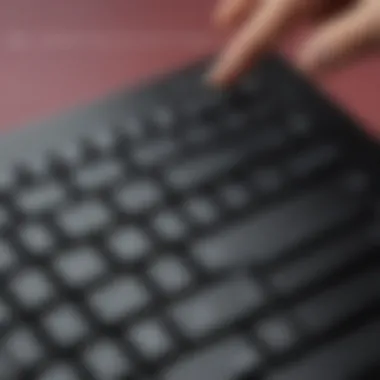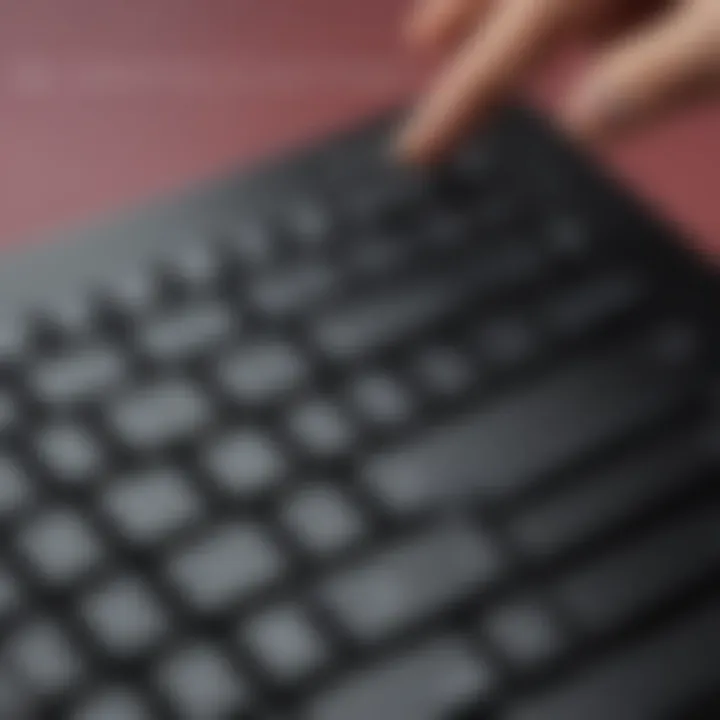Exploring the Android Handwriting Keyboard Features


Intro
In a world where typing on screens has become second nature, the tradition of handwriting seems to be hanging by a thread. Yet, with the advent of the Android handwriting keyboard, we are witnessing a resurgence. This technology breathes new life into the act of writing, allowing users to meld the elegance of penmanship with the convenience of digital devices.
Imagine effortlessly scribbling notes in your own unique style, all while your device converts the flow of ink into text. This guide aims to tackle the nitty-gritty of how the Android handwriting keyboard operates, its benefits, and even where it falls short. It’s not just about the technology; it’s about the user experience and the way people engage with their devices.
In the sections that follow, we’ll dive into the main features of this tool, dissect its place in today’s fast-paced world, and see how it stacks up against conventional typing methods. Join us as we explore this fascinating confluence of technology and traditional handiwork.
Understanding the Android Handwriting Keyboard
The Android handwriting keyboard represents a significant breakthrough in the way users can interact with their devices. As smartphones grow ever more integral to our daily lives, the methods by which we input text are becoming increasingly important. With the advent of handwriting recognition technology, users are now able to input text more naturally and flexibly, catering to individual preferences and styles of writing.
This section aims to elucidate the nuances of the handwriting keyboard, emphasizing its role in enhancing user experience by providing more intuitive and expressive ways to communicate. In an age where swift and effective communication is paramount, understanding how this technology works and its implications can highlight the various advantages it offers.
Definition and Overview
At its core, the Android handwriting keyboard is a software application designed to allow users to write text on their touchscreen devices using stylus tools or fingers. Unlike traditional typing, which relies on a keyboard layout, handwriting recognition translates handwritten input into digital text. This process can be particularly advantageous for those who prefer natural writing or are accustomed to jotting down notes in a more organic manner.
The versatility of the handwriting keyboard is noteworthy. It supports various languages and can adapt to the diverse styles of writing that different users employ. Essentially, it mirrors the way an individual would traditionally handwrite on paper, making the transition to digital text seamless. By fostering a natural input method, the Android handwriting keyboard enhances the overall experience of using smartphones, especially for those who seek alternatives to conventional typing.
How It Works
The functioning of an Android handwriting keyboard hinges on a combination of algorithms and machine learning technologies that analyze the shapes and strokes made by the user.
Here’s a brief overview of the process:
- Input Capture: Users employ their fingers or a stylus to write characters on the screen. The application captures this movement as a series of strokes.
- Stroke Analysis: The system analyzes the strokes in real-time, identifying the unique shape and flow of the writing.
- Character Recognition: Using pattern recognition, the software decodes the handwritten input into corresponding digital characters. This is typically done through neural networks that have been trained on huge sets of handwriting examples.
- Text Output: Once the characters are recognized, the converted text is displayed on the screen, ready for editing or sending as a message.
An important aspect of this technology is its ability to learn from the user. It gradually adapts to individual handwriting styles, honing its accuracy over time. Moreover, many handwriting keyboards provide customization options, allowing for personalized experiences that can further enhance usability.
The ability to write naturally on screens has revolutionized user interaction with their devices, leadin to more efficient communication.
In summary, the Android handwriting keyboard is more than just a tool; it is an innovative solution that caters to the needs of users looking for an alternative to traditional typing methods. It blends the finesse of handwritten communication with the cutting-edge technology of modern smartphones.
Historical Context of Handwriting Recognition
Understanding the historical development of handwriting recognition is paramount to grasp the full potential and functionality of the Android handwriting keyboard. This evolution highlights the technology’s roots, how it has adapted to user needs, and its reliability in digital communication. Knowledge of these early developments provides perspective on the challenges faced and the innovations achieved, shaping the current landscape of handwriting input on mobile devices.
Early Developments
The story of handwriting recognition began many decades ago, long before we saw it on our smartphones. Initial curiosity sprouted with experiments in the 1950s and 1960s when researchers were first learning the ropes about machine recognition of characters. One notable development was the pioneering work done at IBM, where engineers designed devices that could recognize a limited set of handwritten letters. While these early machines were akin to using a hammer to crack a nut, they set the stage for further exploration.
Despite the challenges, including variability in handwriting styles and character recognition accuracy, these early attempts laid foundational knowledge. Over time, researchers and developers began to explore different methodologies, shifting from mechanical devices to simple electronic systems. This evolution began to inspire a broader interest in machine learning techniques, which went on to revolutionize how we view handwriting.
Milestones in Technology
As the years rolled on, significant milestones marked the progression of handwriting recognition technology. The 1980s saw significant advancements due to increases in computational power. Researchers introduced more advanced algorithms that could process handwritten text with better accuracy than previous attempts. This was a game changer.
Fast forward to the late 1990s, when the arrival of personal digital assistants (PDAs) and early smartphones further fueled innovation in this area. Users had more immediate interaction with handwriting recognition software, and companies like Palm introduced programs such as Graffiti, enabling handwriting input on small screens.
By the early 2000s, academic research and practical applications continued to flourish. Neural network approaches emerged, pushing the boundaries of what was possible in character recognition. As technology progressed, major tech companies incorporated handwriting recognition into their operating systems, making it accessible to a broader audience.
"The evolution of handwriting recognition is a fascinating journey of trial and error, innovation, and adaptation to real user needs."
In recent years, deep learning technologies have taken center stage, enabling accuracy levels that surpass earlier systems. As researchers continue to refine these techniques, the future of handwriting recognition appears bright. The combination of AI and sophisticated algorithms has not only refined the technology but also paved the way for the intuitive handwriting input system we are experiencing today on Android devices.
Advantages of Using a Handwriting Keyboard
The undeniable rise of the Android handwriting keyboard has stirred up conversation among tech enthusiasts and casual users alike. The benefits it offers are not limited to mere novelty; rather, they underscore a significant shift in how we interact with technology. As today's smartphones become even more entrenched in daily life, understanding the advantages of using a handwriting keyboard can illuminate why many find this feature appealing.
Enhanced Input Flexibility


One of the standout benefits of handwriting keyboards is their flexibility in input. Traditional typing often confines users to a specific physical arrangement, be it through touch or hardware. Handwriting, however, allows users to write naturally, as if they were jotting down thoughts on a piece of paper. This not only caters to various writing styles but also effectively accommodates different languages and scripts.
Imagine someone who is most comfortable writing in Mandarin characters, yet frequently converses in English. A handwriting keyboard caters to this diversity, allowing seamless transitions between languages without the hassle of changing keyboard settings. Moreover, it breaks down the restrictions imposed by the size of the device. Smaller screens often result in cramped typing experiences, but writing with a finger or stylus offers a more spacious interaction.
- Simplicity: Newcomers, especially seniors or those reluctant to embrace digital interfaces, often find a handwriting keyboard more intuitive. Armchair users might find it easier to express themselves without needing to adapt to thumb typing.
- Situational Versatility: Picture scenarios where one hand is occupied—from holding groceries to balancing a coffee cup. The handwriting input offers a solution by allowing users to write with one hand, adding to the convenience.
Fostering Natural Communication
Handwriting keyboards also play a significant role in fostering more natural communication. When jotting down thoughts by hand, there's a fluidity that mimics conversing in person. This quality of handwriting—its rhythm and nuances—could be argued to carry a personal touch that mere text sometimes lacks.
This human quality in writing speaks volumes about feelings, adding emotional depth that can be harder to convey in a standard typed message.
- Expressiveness: Users can lean into their preferred writing styles. Looser, cursive strokes can convey a level of informality, while more precise writing might evoke professionalism. The ability to vary this style can adjust the tone of communication swiftly.
- Emotional Connection: Handwritten notes, even in a digital form, often feel more personal. The act of writing by hand taps into a cognitive space tied closely to identity and emotion. This can lead to richer connections in conversations that typed messages might lack.
Limitations and Challenges
In any technological advancement, especially one that involves user input methods like the Android handwriting keyboard, it's essential to consider not just the perks but also the limitations and challenges that come into play. While this handwriting keyboard offers a unique input experience, it's not without its bumps in the road. Understanding these shortcomings helps users manage expectations and make informed choices about adopting this tool.
Accuracy Issues
One of the main hurdles with handwriting recognition technology is accuracy of transcripts. Even though algorithms have improved tremendously, they still can't quite match the speed and efficiency of traditional typing for everyone. Errors can stem from different factors:
- Individual Handwriting Styles: Everyone has their unique flair, which can trip up the software. Sometimes, what you see on screen doesn’t match what you intended to write.
- Environmental Factors: Lighting conditions and the surfaces on which people write may affect recognition effectiveness. Scrawling on a bumpy table will yield different results than jotting down notes on a smooth surface.
- Software Limitations: Regular updates can introduce bugs or glitches that temporarily hinder performance.
Users might find themselves frequently correcting mistakes, which can be a hassle. This can lead to frustration, especially in high-pressure situations where precise input is needed. Therefore, it's wise to approach the handwriting keyboard with a sense of flexibility, knowing that some input errors might happen along the way.
Learning Curve for New Users
Transitioning to a new input method often comes with its own set of challenges. Users who are accustomed to typing may find the shift to handwriting input daunting, to say the least. Here are some aspects to consider:
- Familiarization: It can be quite the undertaking to adjust to writing on a screen rather than paper. New users may need time to develop their skills and intuitively navigate the interface.
- Gestures and Commands: Many handwriting apps incorporate specific gestures or commands, which might not always be apparent at first glance. Users often feel lost trying to figure them out, which may lead to frustration.
- Practice Makes Perfect: Just like learning a musical instrument, practice is necessary to reach proficiency. This requirement can be a deterrent for those who prefer quick solutions over a learning journey.
Successfully adapting to handwriting input requires patience and a willingness to learn, which may not be appealing for every user. Nonetheless, as users invest time in familiarizing themselves with the system, they can gradually overcome these hurdles and enhance their overall input experience.
To embrace a new technology, one must be prepared to step beyond the comfort zone of the familiar.
Comparative Analysis: Handwriting vs. Typing
The clash between handwriting and typing isn't just a matter of preference; it's a discussion rooted in varying functionalities and practicalities that affect users on a daily basis. When delving into the realm of text input, understanding this comparative analysis sheds light on which method might best suit different needs and situations. Each has its own advantages, caveats, and potential for enhancing user experience. By dissecting the elements characterizing handwriting and typing, we can provide a clearer perspective for avid smartphone users and tech enthusiasts alike.
Speed and Efficiency
When it comes to speed, typing on a QWERTY keyboard has long been the gold standard for many individuals. Typically, trained typists can clock in speeds between 60 to 80 words per minute, with some adept users pushing past 100. This efficiency stems from a combination of keyboard familiarity and the ability to multitask, allowing users to churn out emails, documents, or social media updates at a rapid pace.
However, it's not all smooth sailing for typing. A handwriting keyboard might not reach that blistering speed, but it offers its own rhythm and flow. For those who have grown accustomed to jotting their thoughts down manually, the tactile feedback of writing can often translate into a more natural pace. Moreover, certain scenarios necessitate the physical act of writing, such as note-taking during meetings or lectures. Here, users tend to focus more on the content than the speed, resulting in a more thoughtful and measured form of communication.
- Key Considerations:
- Usage Context: In fast-paced environments, typing is usually more efficient.
- Personal Familiarity: Users familiar with handwriting might find it a swifter option in creativity-driven tasks.
User Preference Insights
User preferences regarding handwriting versus typing can often be as diverse as the individuals themselves. Various studies highlight interesting nuances in this area. For some, handwriting is synonymous with creativity and personal touch, while others lean toward typing for its technological advantages.
"A handwritten note carries a certain weight; it feels personal, almost intimate."
Among younger generations, there seems to be a growing appreciation for the fluidity of handwriting, particularly in educational settings. Students report that writing by hand aids retention and understanding, while many cite that typing can lead to distraction with various digital notifications.
However, there are practical considerations at play. The advent of smartphones and tablets has opened myriad options for input, prompting users to weigh convenience against nostalgia. Plus, the presence of customizable features on some handwriting keyboards offers an appealing blend of modern technology with traditional methods.
- Factors Driving Preference:


- Task Requirement: For creative writing or brainstorming, handwriting often reigns supreme.
- Cognitive Engagement: Writing by hand may aid memory retention, while typing could foster quicker information retrieval.
In closing, whether one opts for handwriting or typing largely hinges on context, individual habits, and specific needs. Understanding these subtleties allows users to make informed choices that best enhance their interaction with technology.
The Role of AI in Handwriting Recognition
Artificial Intelligence plays a critical role in revolutionizing how we interact with technology, particularly in the realm of handwriting recognition. The integration of AI into handwriting keyboards not only streamlines user input but also enhances the overall experience. As smartphones become ubiquitous, the need for effective input methods grows. Handwriting recognition provided by AI mitigates some annoying issues associated with traditional typing methods, such as autocorrect mishaps or the fatigue of typing on small screens.
The benefits of AI in handwriting recognition are substantial. First off, AI algorithms constantly evolve by learning from user inputs, effectively adapting to an individual’s unique writing style. This adaptability fosters an improved level of accuracy over time, which is paramount for effective communication. Furthermore, AI can analyze and interpret variations in size, slant, and pressure of handwritten characters, making the technology more flexible than most typographical options available.
Machine Learning Techniques
When we talk about machine learning in handwriting recognition, it’s akin to teaching computers to understand and predict based on experience rather than explicit programming. Various techniques underpin this, with supervised learning commonly taking the lead. In supervised learning, a model is trained on a labeled dataset, learning from examples until it can predict with relative accuracy.
For instance, when users write the letter "a", the model observes countless variations from different users, training itself to recognize "a" no matter how it is formed. This iterative process significantly reduces misinterpretation of characters and phrases, leading to greater user satisfaction.
Here are some machine learning techniques that empower handwriting keyboards:
- Support Vector Machines: Effective for small datasets, categorize handwriting into distinct groups for more accurate interpretation.
- Random Forests: Build multiple decision trees to improve robustness; ideal for recognizing complex handwriting styles.
- Hidden Markov Models: Often used for time-series data, suitable for predicting sequences in handwriting motions.
Neural Networks and Deep Learning
Diving deeper, neural networks form the backbone of many advanced handwriting recognition systems. These networks attempt to mimic the way human brains work, processing information through interconnected nodes that model complex patterns.
Deep learning, a subset of machine learning, uses layered neural networks to analyze vast amounts of data, allowing the system to learn features from the information like no other traditional methods can. This is particularly advantageous for recognizing nuanced handwriting styles that can trip up earlier models.
Notably, convolutional neural networks (CNNs) are especially adept at dealing with images, such as handwritten notes or characters. They analyze visual information at multiple resolutions, jumping between layers to abstract the fundamental characteristics of handwriting.
"AI's role in handwriting recognition is a dance of algorithms, constantly adapting to the graceful sway of individual writing styles."
User Experience: Navigating the Interface
In the realm of technology, user experience stands as a linchpin that determines whether a tool is embraced or discarded. The Android handwriting keyboard is no exception. Users often seek an interface that is not just functional, but one that feels intuitive and fluid, ensuring their interaction with the device is seamless.
A well-designed interface can significantly enhance the overall usability of a handwriting keyboard. It should accommodate various preferences, as different users may come with distinct styles of writing and familiarity with digital inputs. When navigating through the keyboard settings, it is essential to have clarity and ease of access to all available features. This simplicity plays a paramount role in how users adapt to the handwriting input method.
Customization Options
The customization options available in an Android handwriting keyboard can make all the difference. Users have various preferences when it comes to keyboard size, color schemes, and even pen styles. Imagine one user enjoys a bold ink effect, while another prefers a softer touch.
- Size Adjustments: Many keyboards offer the ability to modify the size of the input area. A larger space might benefit those who write larger, while others may prefer a compact design to avoid wasting screen real estate.
- Theme Selection: Dark mode or vibrant colors can entirely shift one’s typing experience. Choosing themes that are visually appealing can make interactions more pleasant.
- Pen Styles: Different handwriting styles let users express themselves within the confines of technology. Some keyboards allow users to select from a variety of pen effects, including brush strokes and traditional ink.
These customization features not only provide a sense of ownership over the keyboard but also promote comfort and efficiency during use.
Accessibility Features
Accessibility features are crucial for ensuring that a wide range of users can effectively engage with the handwriting keyboard. It’s not just about making it easier for individuals with disabilities, but also for anyone who might benefit from enhanced readability and usability.
- Voice Input Support: For those who may struggle with physical input, integrating voice recognition can elevate the experience. Users can dictate text, which the software then transcribes, combining the best of both typing and handwriting.
- Visual Enhancements: Options for larger texts or contrast settings can help users with visual impairments. Simple adjustments in display settings can significantly improve comfort when accessing the keyboard.
- Tutorials and Guides: Many Android handwriting keyboards include walkthroughs or tips for those who are new to the method. This can drastically smooth out the learning curve, informing users about optimal use strategies and common pitfalls to avoid.
"A user-friendly interface is key to unlocking a technology's full potential, making accessibility features not just an add-on, but a requirement."
By emphasizing user experience through customization and accessibility, the Android handwriting keyboard not only meets functional demands but also fosters a more inclusive environment for its users. As smartphone technology evolves, maintaining these considerations will remain essential in shaping how people communicate.
Practical Applications in Everyday Use
The integration of handwriting recognition technology has made quite the splash in our digital lives. Particularly, the Android handwriting keyboard presents a slew of practical applications that can significantly improve daily tasks. Knowing how to effectively utilize this tool can lead to enhanced productivity and creativity, whether one is a student, professional, or casual user.
Note Taking and Education
In the educational sphere, the Android handwriting keyboard shines brightly. Students often find themselves inundated with lectures, readings, and the like. Juggling all of this with traditional typing can feel like trying to fit a round peg into a square hole. Writing by hand can enhance memory retention and understanding. The curvature of letters feels different—more personal and engaged compared to tapping away at a screen.


With an Android handwriting keyboard, learners can take notes that truly reflect their understanding. This method mirrors the act of writing on paper but offers the advantages of digital tools. Notes can be neatly organized, and one can incorporate diagrams or doodles to emphasize key points. The ability to convert handwritten notes into typed text also serves as a bonus; this allows sharing with peers or turning notes into a study guide without the hassle of retyping everything.
Moreover, many educational applications are beginning to directly support handwriting input, meaning that students can interact with their learning materials more fluidly, making the learning experience much more immersive and effective. Here’s what students gain:
- Customization: Personalizing notes according to preferences.
- Instant Access: Searching through handwritten notes can be achieved through OCR tech, saving time.
- Engagement: Physical writing often means better focus during lectures.
Creative Writing and Art
Switching gears, the realm of creative writing and art demonstrates even more compelling applications. Many writers appreciate the flow of putting pen to paper, and the Android handwriting keyboard simulates that experience on a digital platform. For novelists, poets, or even bloggers, this maintenance of a free-flowing thought process can lead to more natural writing, capturing the essence of thoughts as they come.
Artists also find value here. Sketching and note-taking can coexist seamlessly, allowing artists to brainstorm ideas, draft stories, or map out characters. Art applications that support handwriting input often enable functionalities like:
- Layering: Crafting multiple elements on digital canvases while writing annotations directly.
- Digitization: Creating a digital path for sketches that can then be colored in or enhanced.
- Accessibility: Sharing creations effortlessly with others or collaborating in real-time with fellow artists.
"The melding of digital and traditional techniques opens countless avenues for expressing creativity, pushing the boundaries of how we see art and writing."
Both educational and creative uses of the Android handwriting keyboard forge a path to more nuanced tools, enhancing traditional methods to suit modern conveniences. Such versatility not only streamlines processes but also enriches the overall experience, making a case for its adoption among a wider audience. Embracing this tech in daily life can transform both learning and creating into engaging, efficient, and enjoyable tasks.
Selecting an Android Handwriting Keyboard
Selecting the right Android handwriting keyboard is paramount for anyone looking to enhance their typing experience. This decision can significantly affect efficiency, user satisfaction, and even the overall ergonomics of how one engages with their device. With various options and features available on the market, it’s essential to weigh the benefits and considerations of individual keyboards before making a choice.
When diving into this topic, consider how the selected keyboard aligns with personal needs. Some users may prioritize speed, while others value design or accessibility features. The right tool can make a world of difference, especially when navigating through texts, notes, or creative projects.
Key Features to Consider
When evaluating handwriting keyboards for Android, several key features stand out:
- Recognition Accuracy: This is perhaps the most critical aspect. A keyboard with high accuracy can translate handwriting with fewer mistakes.
- Smooth Stroke Detection: Look for devices that can recognize and adapt to different writing styles, ensuring your unique penmanship gets captured seamlessly.
- Customizable Input Options: Some keyboards allow users to adjust settings based on their habits or preferences. This can include options for gesture typing or specific shortcuts.
- Multi-Language Support: If you switch between languages, a handwriting keyboard that supports multiple languages can be a game-changer.
- User Interface Design: A clean and intuitive interface can make or break the typing experience. It should be easy to navigate and not cluttered.
- Integration Capabilities: How well does the keyboard integrate with other applications? Smooth interoperability can vastly improve user experience.
Each of these aspects contributes to how effectively and comfortably you can use your device for various tasks. Keep these in mind as you shop around.
Comparison of Available Options
As you sift through the options available, it’s beneficial to compare specific keyboards in terms of the aforementioned features. Here are a few noteworthy apps worth considering:
- Google Handwriting Input: Offers reliable recognition and a broad range of language support. Known for its easy integration with other Google services, it's a go-to for many users.
- MyScript Nebo: Focuses on note-taking and converts handwriting into structured text. It also supports math equations and diagrams, which can be beneficial for students.
- Squid: Aimed primarily at students, this app allows users to take notes naturally, mimicking the feeling of writing on paper.
When comparing these apps, consider usability, personalization options, and any additional features that serve your needs.
"Choosing a handwriting keyboard is like selecting a companion for your digital journey; make sure it complements your style!"
This guide should equip you with a foundational understanding of what to look for and how various options stand against one another. Your writing experience deserves to be enriched, and a properly selected keyboard can catalyze that transformation.
Future Perspectives: Evolution of Handwriting Input
The evolution of handwriting input on Android devices reflects an exciting intersection of technology and human expression. As users increasingly demand seamless interactions with their devices, the future holds a plethora of possibilities. Not only does handwriting input cater to a more personal form of communication, but it also enhances accessibility for those who prefer writing by hand. Understanding these changes is pivotal to appreciating how they might shape user experiences moving forward.
Emerging Trends
As we look ahead, several trends are emerging that promise to reshape how we interact with handwriting keyboards. One noteworthy trend is the integration of augmented reality (AR) in handwriting input. Imagine using a stylus to write on a virtual surface that recognizes your handwriting in real-time. This could transform note-taking and sketching by creating a more immersive environment, allowing users to interact seamlessly with digital content.
Moreover, there is a significant move toward personalization. Handwriting recognition systems are becoming smarter, learning from individual users. Instead of treating handwriting as a one-size-fits-all input method, future systems may analyze a user's unique penmanship style, adapting to it and becoming more accurate over time. This means less frustration and more fluidity in communication.
Additionally, as devices become more interconnected, handwriting inputs may weave into broader ecosystems, enhancing cross-platform compatibility. Users could start a handwritten note on their Android device and access it instantly on their tablet or laptop, blurring the lines between different technologies. Here are some trends to keep an eye on:
- Smart Pen Technology: Incorporating intelligent pens equipped with sensors that convert handwriting to text wirelessly.
- Customizable Input Methods: Allowing users to toggle between cursive, print, or even artistic styles depending on their needs.
- Integration with Cloud Services: Aiding in storage and accessibility, even enabling sharing options with peers or collaborators.
Anticipated Technological Advances
The technological landscape surrounding handwriting input is expected to advance significantly in the coming years. One anticipated breakthrough is improved algorithms for handwriting recognition that could potentially minimize errors. These advancements could hinge on deep learning models that analyze vast amounts of handwriting samples. This could lead to software capable of recognizing a wider range of handwriting styles and variations.
Incorporating machine learning will also further enhance customization. The system could learn your preferred strokes and how you form letters, thereby refining its accuracy over time. Imagine a digital assistant that understands not just your language but your personal style, making digital writing feel as natural as pen on paper.
Another advance could be the incorporation of 5G technology, which would enable near-instantaneous data processing. Users might experience less lag time when writing, creating a smoother experience that feels intuitive. With high-speed internet, cloud-based handwriting tools can function effectively, allowing for real-time collaboration and sharing of handwritten notes or designs.
In short, the future of handwriting keyboards on Android devices seems to be headed for a combine of personalization, connectivity, and accuracy, making it an area worth watching for enthusiasts and casual users alike. The fusion of these advancements will certainly elevate how we communicate and document our thoughts, making handwriting truly a future-forward input method.



